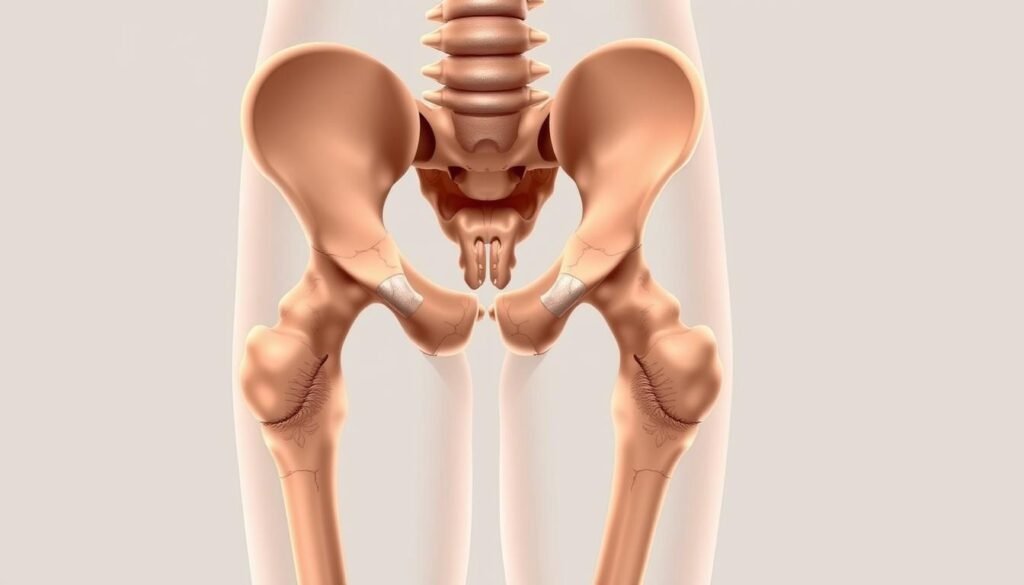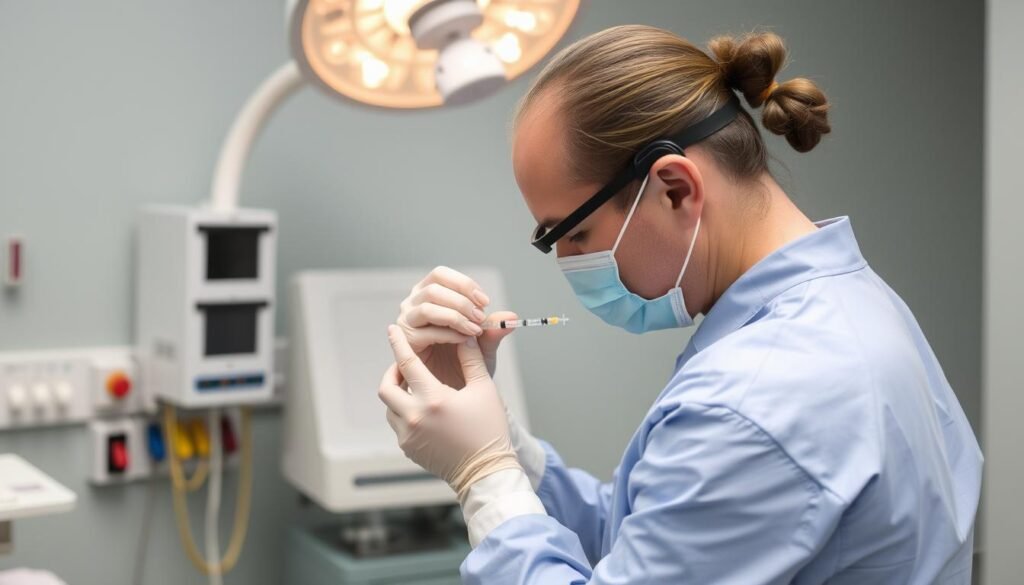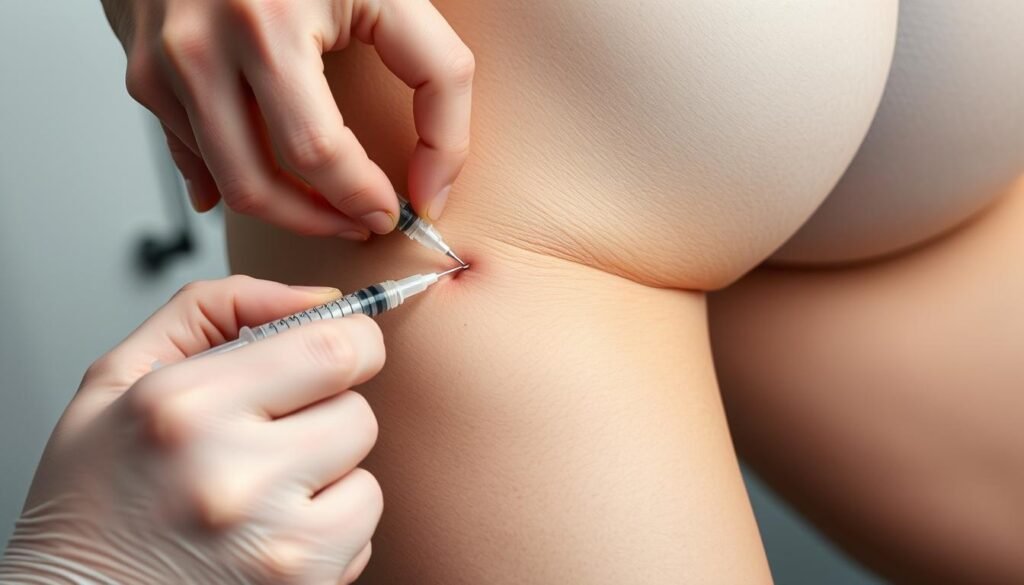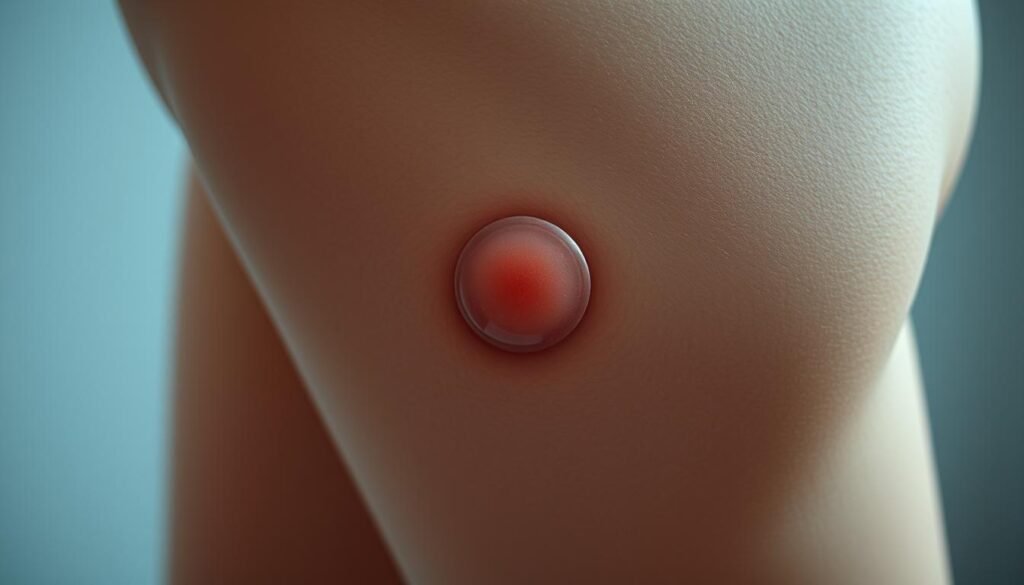Hip pain can be debilitating, affecting daily activities and overall quality of life. For many, the source of this pain is related to the greater trochanteric pain syndrome (GTPS), a condition that involves pain on the outer aspect of the hip.
A specialized medical procedure offers hope for those suffering from this condition. The injection of medication into the affected area can provide significant relief for patients who have not responded to conservative management approaches.
This treatment involves injecting a combination of anesthetic and corticosteroid medications directly into the trochanteric bursa, a fluid-filled sac that reduces friction between tissues. By addressing the root cause of the pain, this therapy can help restore mobility and reduce discomfort.
Key Takeaways
- Greater trochanteric bursa injection is a procedure for alleviating lateral hip pain.
- The injection contains a combination of anesthetic and corticosteroid medications.
- This therapy is beneficial for patients who haven’t responded to conservative management.
- The procedure targets the trochanteric bursa, a fluid-filled sac reducing friction between tissues.
- It helps in restoring mobility and reducing discomfort associated with hip pain.
Understanding Greater Trochanteric Pain Syndrome
Understanding the complexities of Greater Trochanteric Pain Syndrome is crucial for effective diagnosis and treatment. This condition affects the hip area, causing significant discomfort and impairing mobility.
What Is Greater Trochanteric Pain Syndrome?
Greater Trochanteric Pain Syndrome (GTPS) refers to pain on the outer aspect of the hip, typically centered around the greater trochanter. This condition involves inflammation of the trochanteric bursa, a fluid-filled sac that reduces friction between the bone and surrounding soft tissues. The syndrome is characterized by pain and tenderness over the lateral hip region.
Anatomy of the Greater Trochanter Region
The greater trochanter is a prominent bony structure on the femur that serves as an insertion point for several hip muscles. The trochanteric bursa is positioned between the greater trochanter and the overlying gluteus maximus muscle and iliotibial band. Multiple bursae are present in this area, including the subgluteus maximus, medius, and minimus bursae, which cushion the bone and soft tissues, reducing friction during movement.
- The gluteus medius and minimus tendons insert onto the greater trochanter, playing crucial roles in hip stabilization and gait mechanics.
- Understanding this complex anatomical area is essential for proper diagnosis and treatment of conditions affecting the lateral hip region.

Causes and Symptoms of Trochanteric Bursitis
Trochanteric bursitis, characterized by inflammation of the bursa near the greater trochanter, is a significant cause of hip pain. This condition leads to discomfort and affects the quality of life for those afflicted.
Common Causes of Trochanteric Bursitis
Trochanteric bursitis is often caused by repetitive motion or direct trauma to the hip area. Activities that involve running, cycling, or repetitive hip movements can irritate the bursa, leading to inflammation. Poor posture, inadequate footwear, or an abnormal gait can also contribute to the development of this condition.
- Repetitive stress or overuse
- Direct trauma to the hip
- Poor posture or gait abnormalities
Recognizing the Symptoms
The symptoms of trochanteric bursitis include pain on the outer aspect of the hip, which can radiate down the thigh. Tenderness to palpation over the greater trochanter is a hallmark sign. Patients often report pain that worsens with activity and improves with rest.

- Pain on the lateral aspect of the hip
- Tenderness to palpation over the greater trochanter
- Pain that worsens with activity
- Possible radiation of pain down the lateral thigh
Diagnosing Greater Trochanteric Pain Syndrome
The diagnosis of Greater Trochanteric Pain Syndrome is primarily clinical, supported by specific physical examination techniques and, when necessary, imaging studies. A thorough diagnostic process is crucial for distinguishing GTPS from other causes of hip pain.
Physical Examination Techniques
Physical examination plays a vital role in diagnosing GTPS. Healthcare providers use specific techniques to assess tenderness over the trochanteric area. Patients with GTPS typically exhibit tenderness to palpation over the greater trochanter. The examination may also involve assessing pain upon resisted hip abduction and external rotation.
Imaging Studies and Their Role
While not always necessary, imaging studies can help rule out other conditions and confirm the diagnosis in challenging cases. Ultrasound and MRI are particularly useful for visualizing the bursa and tendons around the greater trochanter. MRI provides a comprehensive evaluation, showing detailed images of the bursa, gluteal tendons, iliotibial band, and surrounding soft tissues. According to a study published in Arthritis Rheum, MRI findings in GTPS may include bursal fluid collection, tendinopathy of the gluteus medius or minimus, or tears of these tendons (1).
For most patients with typical presentation, diagnosis can be made clinically without extensive imaging, emphasizing the importance of a thorough physical examination in the diagnostic process.
Greater Trochanteric Bursa Injection Procedure

The greater trochanteric bursa injection involves administering medication directly into the affected bursa to reduce pain and inflammation. This procedure is typically considered for patients who have not responded to conservative treatments.
Preparation for the Procedure
Before the injection, the patient’s hip area is cleaned and prepared with an antiseptic solution to minimize the risk of infection. The skin may be numbed with a local anesthetic to reduce discomfort during the procedure.
Patient Positioning and Technique
The patient is usually positioned on their side with the affected hip facing upwards. The healthcare provider identifies the injection site by palpating the greater trochanter and uses a needle to inject the medication into the bursa.
Medications Used in the Injection
The medication mixture typically includes both a corticosteroid and a local anesthetic such as lidocaine or bupivacaine. The corticosteroid, such as methylprednisolone, helps reduce inflammation, while the anesthetic provides immediate pain relief. The mixture is drawn into a syringe and injected slowly through the needle.
Benefits and Effectiveness of Bursa Injections
Research has shown that bursa injections can provide significant relief for patients with greater trochanteric pain syndrome. The effectiveness of this treatment is attributed to the reduction of inflammation and alleviation of pain in the affected area.
Short-Term Pain Relief
In the short term, corticosteroid injections have been shown to be highly effective in reducing pain and inflammation associated with trochanteric bursitis. Studies have indicated that a significant proportion of patients experience rapid relief following the injection.
Long-Term Outcomes and Success Rates
The long-term outcomes of greater trochanteric bursa injections vary, with research indicating that approximately 40-50% of patients maintain significant pain relief at 6 months. A study published on https://pmc.ncbi.nlm.nih.gov/articles/PMC9123821/ supports the efficacy of this treatment. Combining corticosteroid injections with therapy has been shown to produce better long-term outcomes than injections alone.
| Treatment Approach | Short-Term Relief | Long-Term Success Rate |
|---|---|---|
| Corticosteroid Injection Alone | High | 40-50% |
| Corticosteroid Injection with Therapy | High | Higher than injection alone |

Potential Risks and Side Effects
Greater trochanteric bursa injections, while effective for hip pain relief, are not without potential risks and side effects. As with any medical procedure involving a needle and injection, there are considerations to be taken into account to minimize complications.

Common Side Effects
Common side effects of greater trochanteric bursa injections include temporary pain or discomfort at the site of the injection, mild skin reactions such as redness or swelling, and potential side effects from the corticosteroid used. These effects are typically mild and resolve on their own within a few days.
Rare but Serious Complications
While rare, serious complications can occur. These include infection, which can be serious if not promptly treated. Allergic reactions to the corticosteroid or anesthetic used in the injection can also occur, ranging from mild to severe. Tendon weakening or rupture is another potential complication, particularly with repeated injections. Systemic absorption of corticosteroids like methylprednisolone can temporarily affect the hypothalamic-pituitary-adrenal axis in some individuals. “Necrotizing fasciitis as a complication of injection into greater trochanteric bursa,” as reported in medical literature, highlights the importance of strict sterile technique during the procedure.
Post-Injection Care and Recovery
Effective recovery after a greater trochanteric bursa injection involves a combination of rest, activity modification, and rehabilitation exercises. Proper post-injection care is essential to maximize the benefits of the treatment and minimize potential complications.
Immediate Aftercare Instructions
Following the injection, patients are advised to avoid strenuous activity involving the injected region for several days. A follow-up appointment should be scheduled within three weeks to assess the treatment’s effectiveness. Patients should gradually increase activity levels after the initial 24-48 hour rest period.
Activity Modifications and Return to Normal Function
To facilitate recovery, several activity modifications are recommended:
- Avoid activities that compress the lateral hip, such as sleeping on the affected side or prolonged sitting in a low position, for 1-2 weeks.
- Incorporate stretching exercises for the iliotibial band and hip muscles into the recovery program as directed by healthcare providers.
- Strengthening of the hip abductor muscles is crucial for long-term recovery and prevention of recurrence.
- Considerations regarding footwear and gait mechanics may be important, with some patients benefiting from orthotic devices.
- Patients taking certain drugs, including blood thinners, may have specific activity restrictions following the injection.
By following these guidelines and maintaining proper body mechanics during daily activities, patients can optimize their recovery and improve the long-term outcomes of the treatment.
Conclusion
Trochanteric bursal injection offers a promising solution for individuals suffering from lateral hip pain. The procedure involves precise needle placement at the point of maximal tenderness over the greater trochanter, followed by injection of anesthetic agents like lidocaine and corticosteroids such as methylprednisolone.
When performed with proper technique and considerations of patient anatomy, these injections can provide significant pain relief and improved function for many patients. The success of the therapy depends on accurate diagnosis, proper patient positioning at approximately 30-45 degrees of hip flexion, careful palpation of anatomical landmarks, and precise needle insertion.
For optimal outcomes, injections should be combined with appropriate physical therapy, activity modifications, and addressing underlying biomechanical issues. Advances in imaging guidance and injection technique continue to improve the precision and effectiveness of this therapeutic intervention for patients suffering from lateral hip pain.

